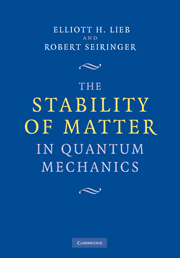Book contents
- Frontmatter
- Contents
- Preface
- 1 Prologue
- 2 Introduction to Elementary Quantum Mechanics and Stability of the First Kind
- 3 Many-Particle Systems and Stability of the Second Kind
- 4 Lieb–Thirring and Related Inequalities
- 5 Electrostatic Inequalities
- 6 An Estimation of the Indirect Part of the Coulomb Energy
- 7 Stability of Non-Relativistic Matter
- 8 Stability of Relativistic Matter
- 9 Magnetic Fields and the Pauli Operator
- 10 The Dirac Operator and the Brown–Ravenhall Model
- 11 Quantized Electromagnetic Fields and Stability of Matter
- 12 The Ionization Problem, and the Dependence of the Energy on N and M Separately
- 13 Gravitational Stability of White Dwarfs and Neutron Stars
- 14 The Thermodynamic Limit for Coulomb Systems
- List of Symbols
- Bibliography
- Index
13 - Gravitational Stability of White Dwarfs and Neutron Stars
Published online by Cambridge University Press: 20 December 2010
- Frontmatter
- Contents
- Preface
- 1 Prologue
- 2 Introduction to Elementary Quantum Mechanics and Stability of the First Kind
- 3 Many-Particle Systems and Stability of the Second Kind
- 4 Lieb–Thirring and Related Inequalities
- 5 Electrostatic Inequalities
- 6 An Estimation of the Indirect Part of the Coulomb Energy
- 7 Stability of Non-Relativistic Matter
- 8 Stability of Relativistic Matter
- 9 Magnetic Fields and the Pauli Operator
- 10 The Dirac Operator and the Brown–Ravenhall Model
- 11 Quantized Electromagnetic Fields and Stability of Matter
- 12 The Ionization Problem, and the Dependence of the Energy on N and M Separately
- 13 Gravitational Stability of White Dwarfs and Neutron Stars
- 14 The Thermodynamic Limit for Coulomb Systems
- List of Symbols
- Bibliography
- Index
Summary
Introduction and Astrophysical Background
Up to now we have been concerned with demonstrating the ‘Triumph of Quantum Mechanics’, which is that the electrostatic forces between the electrically charged particles that make up ordinary matter do not cause collapse (provided the maximum nuclear charge Z and the fine-structure constant α are not too large). The total energy is not only finite but it is proportional to the particle number. Electric and magnetic forces conspire to cancel out to a comfortable extent, but lurking in the background is a very, very much weaker force–gravity. This force is additive, however, and there can be no cancellation as there is for electric forces, but because it is so weak it becomes dominant only when N is very large – of the order of the number of particles in a star, which is about 10.
It was already realized shortly after the publication of Schrödinger's equation that a star would collapse under the influence of gravity if the kinetic energy of the particles is treated relativistically and if the number of constituent particles exceeds a certain critical value; this critical value depends on Planck's constant, h.
There are two kinds of stars to consider. One is a star made of electrically neutral particles called neutrons, and which is itself the residue of a collapsed star. Its mass is typically of the order of 1–2 solar masses, but gravity squeezes it to a radius of about 10–20 km. In contrast, the radius of our sun is roughly one million kilometers.
- Type
- Chapter
- Information
- The Stability of Matter in Quantum Mechanics , pp. 233 - 246Publisher: Cambridge University PressPrint publication year: 2009



